Collecting seeds from your garden is not only fun, it’s a great way to save yourself some cash! In this post, I’ll show you everything you need to know about harvesting seeds, so you will have the best success.
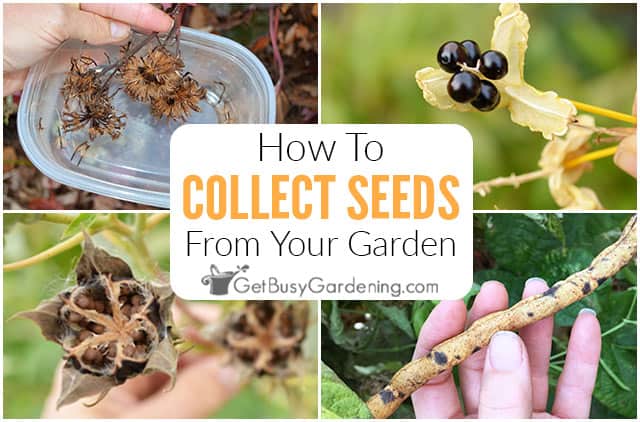
One of the best ways to save money on your garden is to harvest seeds from your existing plants.
I collect as many seeds from my garden as I can every year. It’s a simple and fun way to get free seeds to keep year after year!
Plus, I use them to trade for other varieties that I don’t already have, saving myself even more money!
Gathering seeds from your garden may seem tedious, but it is so much easier and faster than you might think.
In this comprehensive guide for collecting your own seeds, you will learn all of my tips and tricks. This will make the process go smoothly, and leave you with plenty of viable seeds with very little effort.
What Is Seed Collection?
Simply put, seed collection is the process of harvesting and saving seeds. And it’s not something that can only be done by the experts, or large companies either.
Many home gardeners do it to save money, or keep their favorite varieties from year to year – or even passing them down for generations.
Once you know the rules to follow, and the techniques to use for collecting seeds from your backyard, you’ll become a pro in no time.
Types Of Seeds To Collect
Before you go out and start gathering seeds, it’s important to understand that not all of them are created equal.
Some plants won’t produce viable seeds, which is a waste of your time. While others won’t grow true from seed, leaving you with mystery specimens.
So, unless you like to experiment, it’s best to only collect seeds from plants that are heirloom and/or open pollinated.
You certainly could gather seeds from hybrids. However, since they are a cross between two different parents, you don’t usually get the same variety as the one the seeds came from.
Or worse, they could be sterile. And it’s not just a problem with commercially produced seeds either. Cross pollination can happen in nature too.
While some plants self-pollinate, many need to be pollinated by others. So, unless you’re sure yours was far enough away from other varieties that it could cross with, you may also end up with a mystery.
You can still collect seeds from cross-pollinated plants. But, if they were pollinated by other varieties (like squash crossed with cucumbers), then you may end up with something very different than you were expecting.
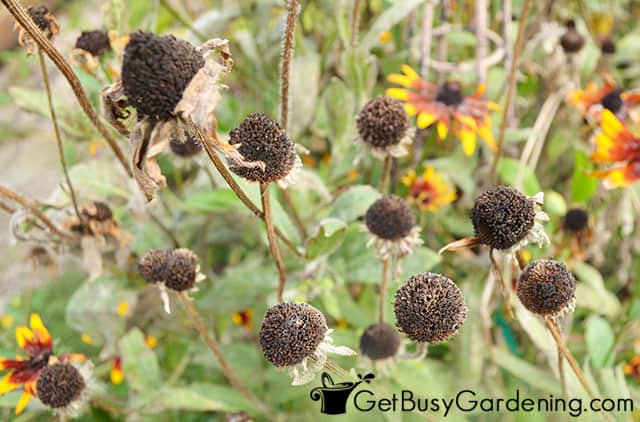
Easiest Seeds To Harvest For Beginners
Now that we’ve got all of the technical mumbo jumbo out of the way, let’s move on to the fun part! Which seeds are the easiest to collect.
If you’ve never harvested seeds from the garden before, start with the easy stuff. Here’s a list of some of the easiest ones to get you started…
- Vegetables – beans, chard, radishes, peppers, peas, spinach, lettuce
- Herbs – cilantro, basil, dill, anise hyssop, lavender, mustard, chives
- Annuals – snapdragon, petunia, cosmos, castor bean, sunflower, morning glory, marigold, zinnia, nasturtium
- Perennials – hollyhock, black-eyed Susan, gaillardia, butterfly weed, poppies, balloon flower, gaillardia, rudbeckia, cone flower, lupine, milkweed, liatris, clematis
- Tropicals – canna lily, plumeria, spider plants, coleus, yucca, datura, hibiscus
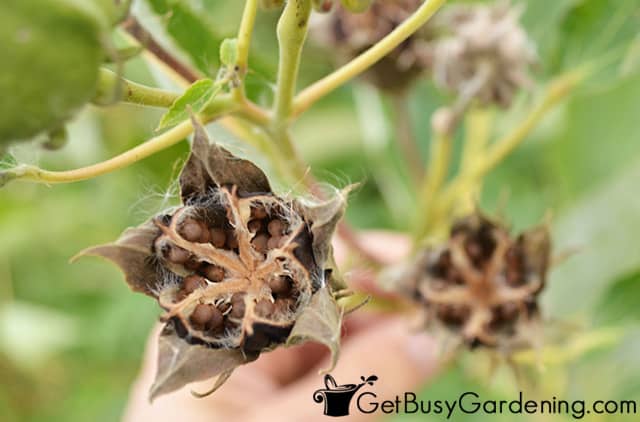
Where Are The Seeds Located
There are three main spots on a plant where seeds can be found. They will either be located where the flowers once were, contained within a seed pod, or inside of the fruit.
Spent Flower Heads
Many types of annuals, perennials, herbs, and vegetables will produce seeds either inside of a flower head, or at the tips of the stem after the blossoms fall off.
These types of seeds are usually pretty easy to spot, and the best ones for beginners to start with.
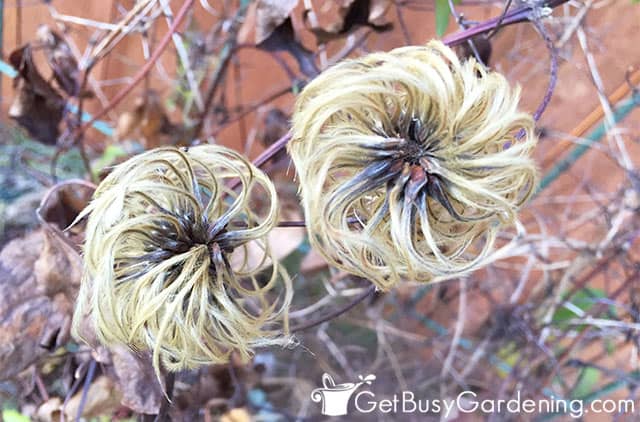
Seed Pods
Some plants form pods after the blooms fade, which is where the seeds are located. These pods can come in many different shapes and sizes.
You’ll find them anywhere from the tiny ball-shaped pods of morning glories, to the larger round pods on poppies.
There are even alien-looking ones, like those that form on snapdragons and petunias. These can be much harder to identify, and finding them can take some practice.
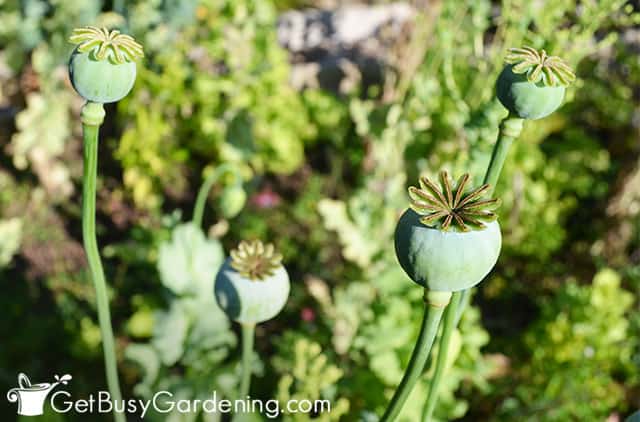
Inside The Fruits
The other common place where seeds are located is inside of the fruit. These are often the most difficult ones to harvest, and may require special treatment in order to be viable.
Also, some types of vegetables must become overly ripe in order for the seeds to mature, and they will no longer be edible. Which means you will have to sacrifice some of your crop in order to get seeds.
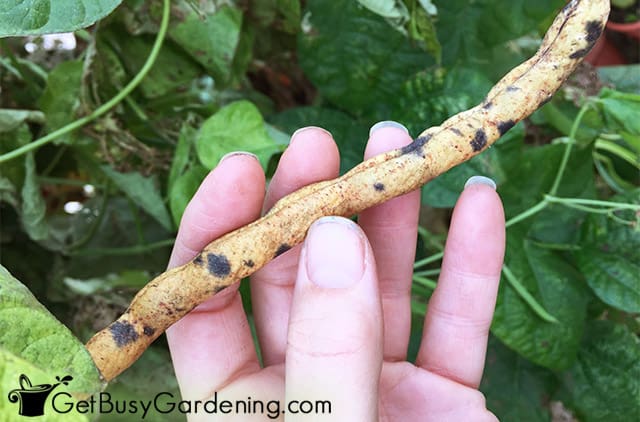
When To Collect Seeds
Timing is everything for success with harvesting seeds. If you collect them too early, they may not be mature enough to germinate.
But if you wait too long, they could drop, be eaten by the birds, or blow away in the wind. There’s nothing more frustrating than being left with an empty stem or seed pod.
Don’t worry, once you get the hang of collecting seeds, you’ll be able to easily tell when they are ready to be harvested.
How To Tell When To Harvest Seeds
In general, you will know the seeds are ready when the pod or flower head is brown and dried out. Sometimes the pod will break open, and you can see the seeds spilling out.
If you’re not sure whether they are ready to be harvested, it’s probably best to wait. Keep checking every day until you see the seeds.
As for time of year… in general, fall is a great time for collecting seeds. However, many types of plants form them earlier in the season, so you can usually get started sometime in early to mid summer.
Oh, and you don’t have to worry about the temperature either. You can keep harvesting seeds as long as the weather cooperates (even in the snow!).
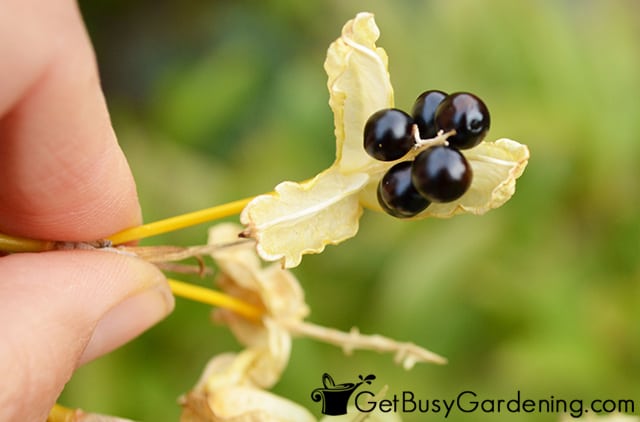
Methods For Collecting Seeds
For home gardeners, there are two main methods for harvesting seeds. You can simply clip off the whole flower head, pod, or fruit, and bring them inside. Or, you can gather the individual seeds right in the garden.
There’s really no right or wrong answer here. Many times it depends on the type of plant, where the seeds are located, and which technique is easiest for you.
How To Collect Seeds From Your Garden
The actual steps you take for harvesting seeds can be different, depending on the type of plant. So, below I will give you some tips and quick steps for how to retrieve seeds from your garden.
Supplies Needed:
- Collection container (plastic bowl, small bucket, baggie, or a paper bag)
- Sharp mini-snip pruners (optional)
Collecting Seeds From Flowers
Blooming plants will either have seeds in a pod, or right inside of the flower. Either way, they won’t produce them until after the blossoms have faded and died.
So, if you want to collect seeds from flowers, don’t deadhead them. Instead, leave a few on the plant, and allow them to die back. The pedals may or may not fall off, depending on the species.
Here are the quick steps for how to harvest seeds from flowers…
- Wait until the head or seed pod is brown and completely dried out – some may even split open.
- Clip off the entire thing using sharp pruners, and drop it into a small plastic bowl, bucket, baggie, or a paper bag.
- Cover the container, or fold over the top of the bag, and then shake it to release the seeds.
- Alternatively you could pinch the seeds out of the pods or flower head, and drop them into your container.
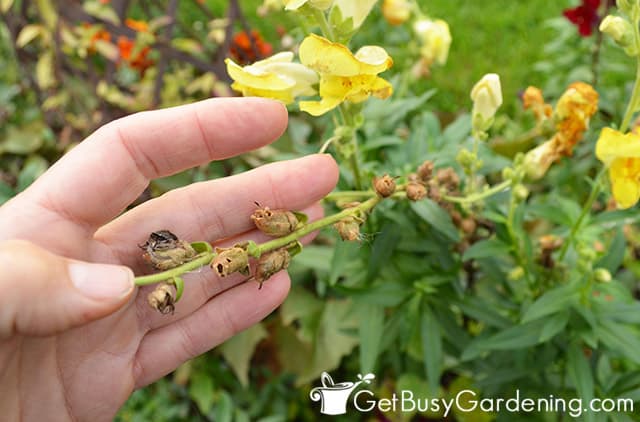
Harvesting Seeds From Fruits And Vegetables
Some vegetables have seeds inside of the fruit, like squash, cucumbers, tomatoes, beans, and peas.
Others will form them after the plant has bolted (flowered), as is the case for leafy greens, root crops, and crucifers.
In most cases, the seeds won’t be viable until after the vegetable is no longer edible. But some can be saved from ripe fruits before you eat them.
Here are the quick steps for harvesting seeds from vegetables…
- Clip the fruit, pod, or seed heads off the stem, and bring them inside.
- Cut or break it open to retrieve the seeds.
- Alternatively, you could crack open the pods or pinch the seeds from the plant, and drop them into your collection container.
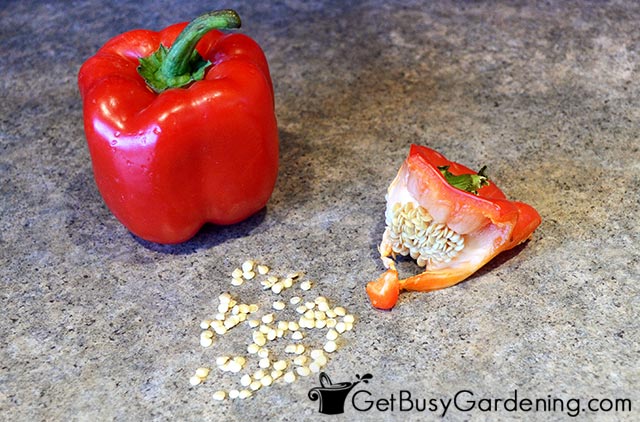
Collecting Herb Seeds
In order to produce seeds, herbs must bolt or blossom. Some will no longer be edible after they start bolting. But others you can continue to enjoy even after they bloom.
The process of gathering herb seeds is similar to other blooming plants. Simply clip off the dead flower, or pinch the seeds from the top of the stem.
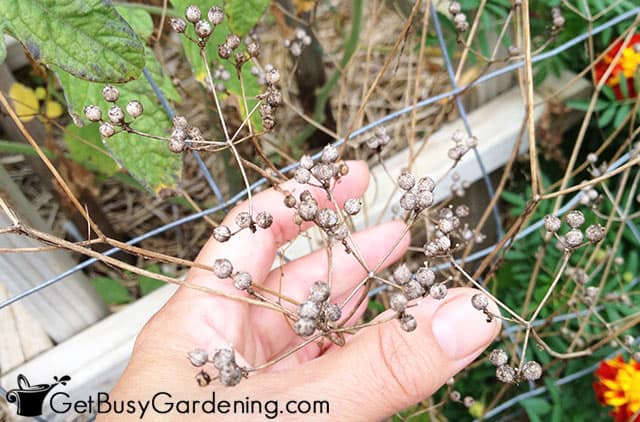
What To Do With Seeds After Harvesting
Once you’re done collecting all of the seeds you want, it’s important to clean them properly, and allow them to dry out completely before storing them.
Separating Them From The Chaff
Chaff is the extra plant material that tends to be included when you collect seeds. This usually consists of stem, flower, and/or pod pieces.
If the seeds are located inside of the fruit, sometimes there is a gel coating around them, which also needs to be removed.
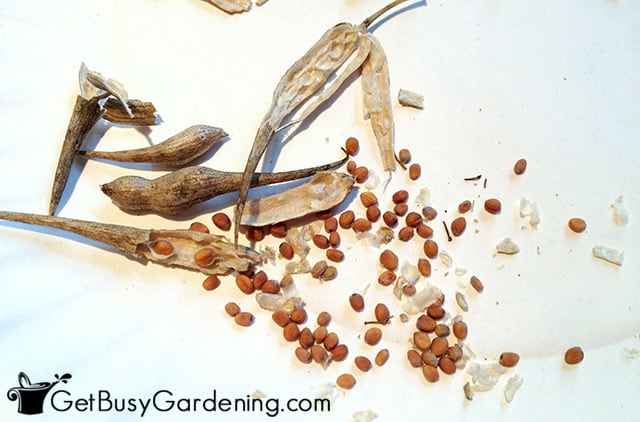
Drying Seeds After Collecting Them
Spread the seeds on a paper towel, screen, or newspaper, and allow them to dry out completely. Don’t let them sit in the plastic bag or container, or they may get moldy.
The larger the seed, the longer it will take to dry. If they were wet when you harvested them, or inside of the fruit, then they will take longer to dry as well.
To ensure they are completely dried, let them sit out for at least a month.
How To Save Seeds For Next Year
Once your collected seeds are dry, you can store them in plastic, glass, or paper. I like to put mine into small containers or coin envelopes, and then keep them in a larger plastic box.
If you want to organize yours better than that, put them into pocket sheets and keep them in a 3-ring binder. Or organize your envelopes in a cute storage box.
Learn all about storing seeds the right way in this detailed guide.
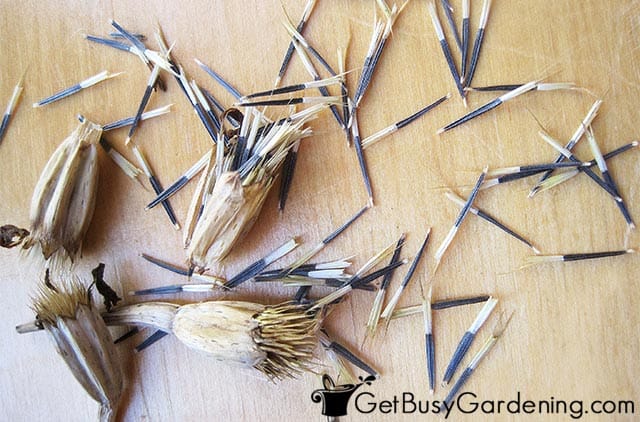
Collecting seeds is fun, simple, and a great way to save money. Plus you’ll be able to grow your favorite plants from year to year for free.
Up Next: Learn how to grow all of your seeds in this detailed guide.
If you’re tired of struggling, and want to learn how to grow any plant you want from seed, then enroll in my online Seed Starting Course. It’s a wonderful, fun, self-paced course that will teach you everything you need to know to easily grow your own seedlings. Enroll and get started today!
Or, if you just need a refresher, then my Starting Seeds Indoors eBook is for you! It’s a quick-start guide that will get you planting seeds in no time.
Recommended Books
- Starting & Saving Seeds
- The Gardener’s Guide to Growing and Storing Vegetable and Flower Seeds
- The Complete Guide to Saving Seeds
- Seed Saving and Growing Techniques for Vegetable Gardeners
More Seed Saving Posts
Share your tips for collecting seeds in the comments section below.
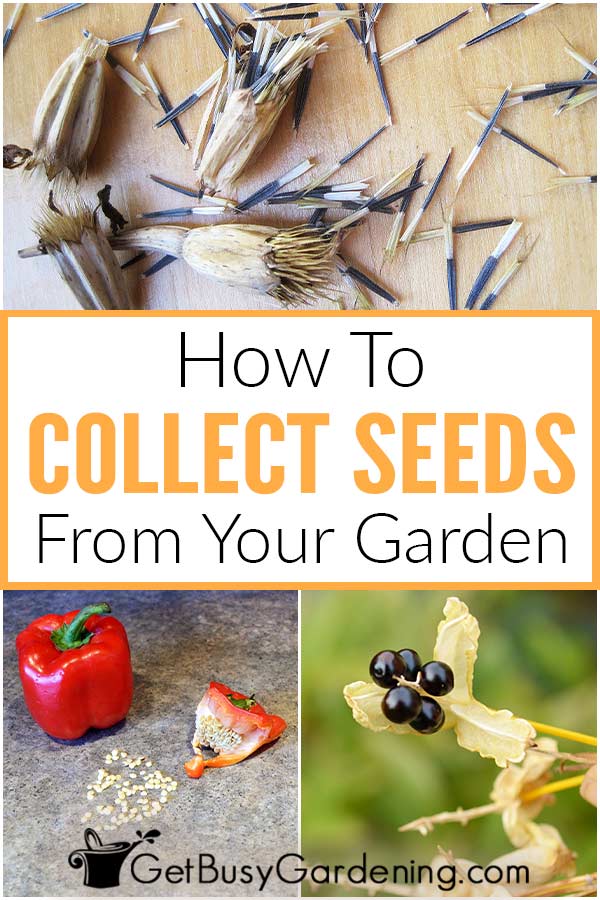
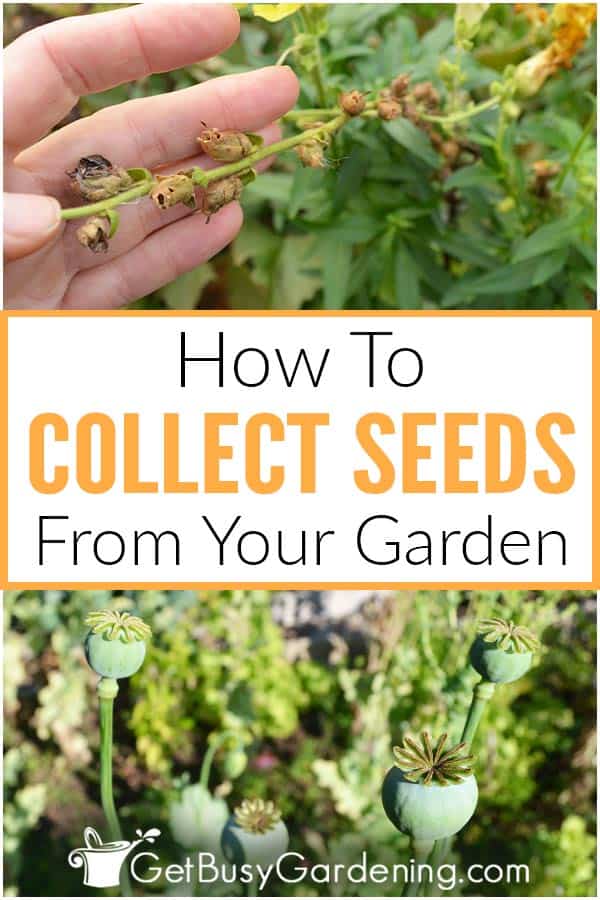
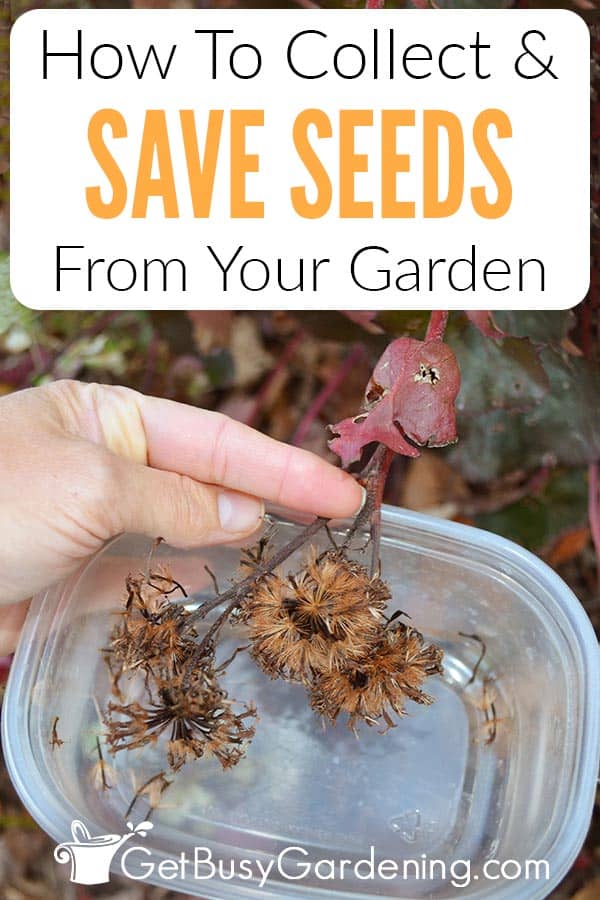
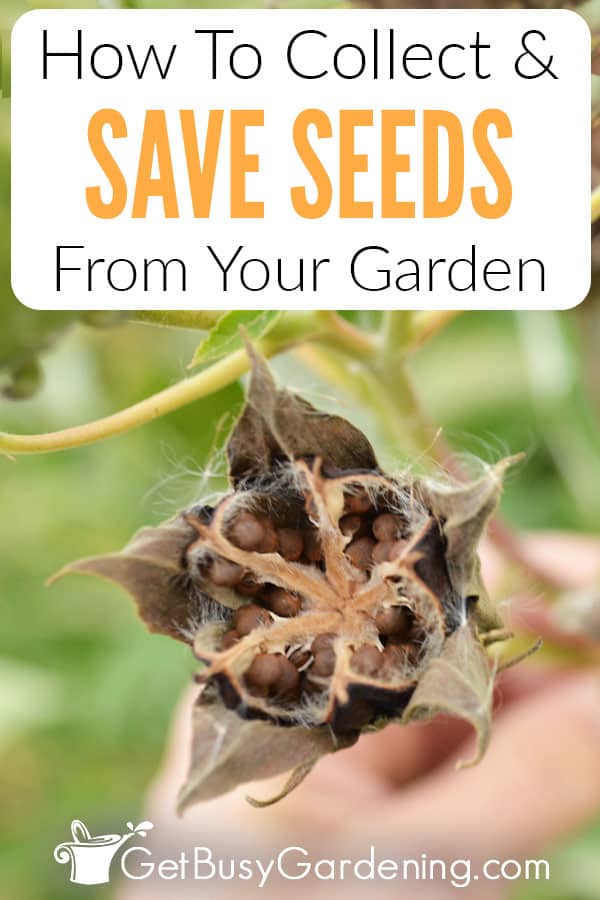
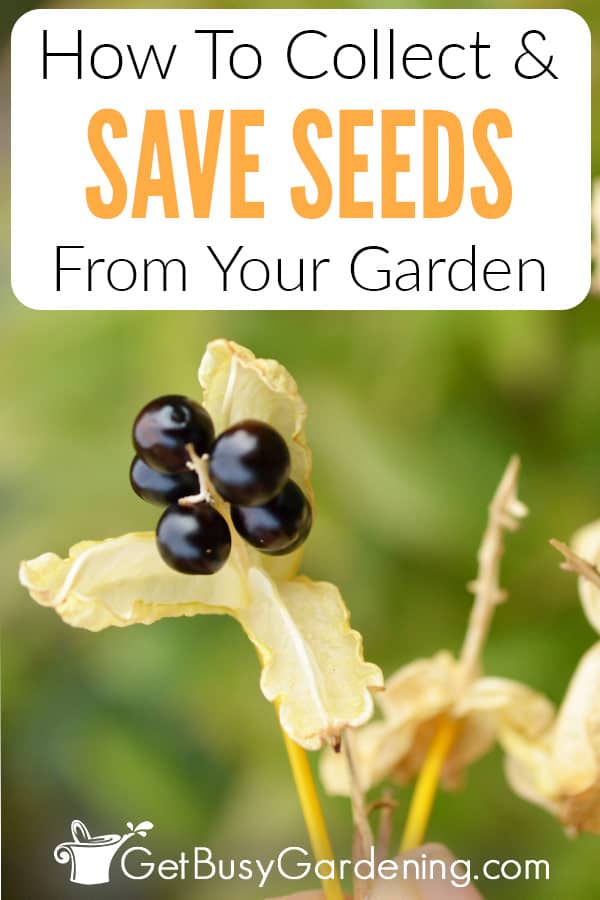
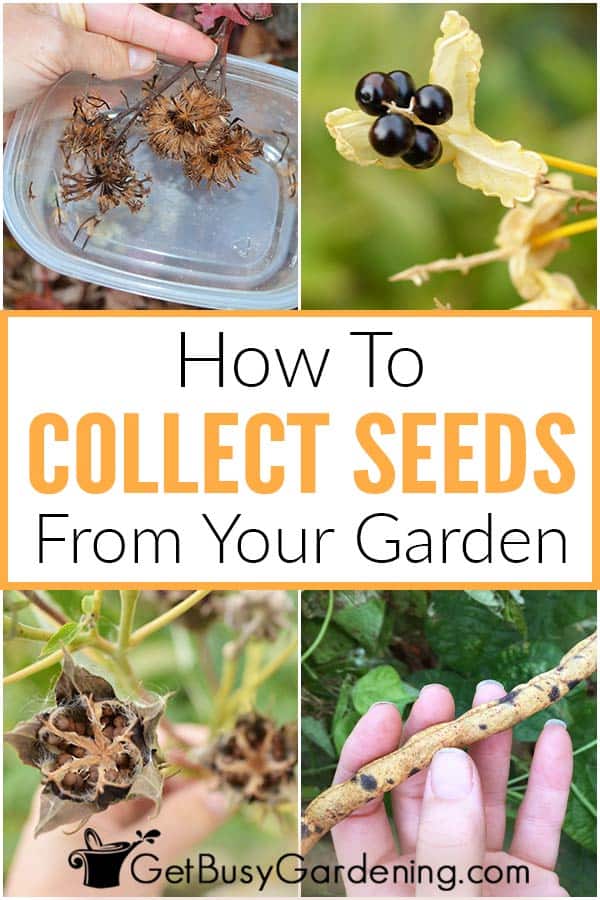

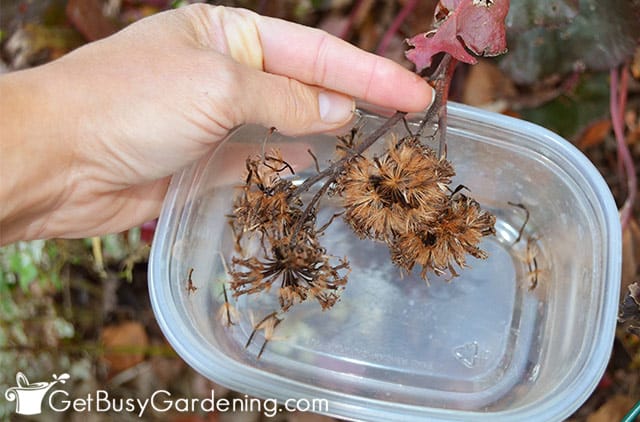


Cheryl K says
Hi Amy, Do we need to wait until the plant is completely brown to save the seeds? Or can we clip and dry them indoors? Ive been waiting 2 months already for my daikon radish & curly kale to dry in the garden so I can save seeds and plant something new. Problem is, they are taking up a ton of space with just a few plants.
Amy Andrychowicz says
You don’t need to wait until the whole plant dries up, just the seed pods. It’s best to leave the pods on until they turn brown a dry out, otherwise the seeds may not be viable.
Helga Miller says
Please comment about Nasturtium seeds. I’ve had a lot of them and they have all these green buds which I presume hold the seeds. Can I just pick them and dry them for next year’s crop or do I need to break them open. Some have even fallen on the ground.
Thanks in advance for your answer! Love you column and read everything you post but I could not clean my mandarin tree before bringing inside. It gets too cold overnight at our altitude but it always is infected with aphids or this white stuff that attracts wasps. There is constant damage control but it has survived for almost a decade with hosing it off and removing the bugs by hand with alcohol.
Amy Andrychowicz says
Yes, you can just pick the seeds and dry them for next year. No need to break them open, the brain-looking thing is the whole seed. It will turn brown and shrivel a bit when it dries, and you’ll plant the whole thing next year. You can also collect the seeds that have fallen to the ground, they drop off when they’re ready, so that makes it even easier!
Thanks for your nice comment about my website, so glad you like it and thanks for being a loyal reader! 🙂 And yes, bug control is always a battle, but worth it to save our favorite plants!
Helga says
Thanks Amy for the answer I was looking for and I will have so many Nasturtium seeds for another bumper crop next year. Love to eat them in my salad too! ❤️
Amy Andrychowicz says
You’re welcome, happy to help. Enjoy!
Lisa says
I have so many flowers that are off shoots from grand mother’s and my moms flowers . I am try everything I can to keep them going . My biggest problem is shade. I let my husband buy a chain saw to get me more sun
Amy Andrychowicz says
Awesome, I love it when plants have a history! Saving seeds from family plants is such a great way to expand you collection. 🙂 I’m struggling with too much shade these days too. Humm… maybe I should buy my hubby a chainsaw. LOL!
Yvonne says
This is my first year gardening and I have a radish plant that never bulged up and the stalk grew really thick. I could see something was different so I just let it keep going and it is now producing flowers yay! My first thought was if I save the seeds I won’t have to buy next time around. And that’s what led me to this article. Thanks a bunch for sharing your insight.
Amy Andrychowicz says
You’re welcome! Good luck harvesting the seeds. 🙂
bob wasson says
I have several carrot plants that are going to seed (with many groups of seeds per plant) when and how should I collect them (especially when cause dont want them all growing in one place)?
Amy Andrychowicz says
You’ll know the seeds are ready to harvest once they start turning brown. If you’re worried you won’t get to them fast enough, you could wrap the flower heads in a mesh bag so they won’t fly away. Once they’re ready to harvest, you can just cut the whole flower head and bring it inside to dry.
Barb says
So after gathering & drying seeds,should you wait til the next spring to plant or plant right away & give them a head start for the next year?
Amy Andrychowicz says
It depends on the type of seed you’re collecting. I save most of my garden seeds to grow next year. But many types of perennials, hardy annuals and hardy herbs can be direct sown in the fall and will grow in the spring.
Elaine Tuohy says
Hi! Good article. I know how big hibiscus seeds are from your pics, but my hibiscus seeds are about 1mm. They look like little letter c’s. At first I thought they were just not mature, but I understand that when the calyx(?) dries up, turns brown and falls off the plant, they were ok to harvest. The ovary is 1 cm long, a lot smaller than what is in your pics. Are these seeds? Or am I wasting my time harvesting these? I would like to post a pic, but it won’t let me. I appreciate any help you can give. Thanks, Elaine
Amy Andrychowicz says
There are tons of different varieties of hibiscus plants, and the seeds can definitely look different depending on the variety you’re growing. From the way you describe them, it sounds like those are indeed the seeds you’re collecting. If you want, you can post a photo to my FB page, or tag me on Instagram or Twitter with a photo.
Sandra Hahn says
I take plant seeds off of public gardens all the time. It”s fun
Kitty says
This spring, a local church offered free classes on seed saving. It was great. They had 5 scheduled two hour classes on different aspects of saving seeds. I partnered up with a friend and met many new friends. This month (September) they are having two follow up classes, one on basic canning and the last will be a seed saving swap for the season.
I have tomato seeds and my favorite surprise will be Long Island Cheese (a beautiful tasty pumpkin squash) seeds to share.
I book marked your excellent site site awhile ago!
Thanks for the great posts.
Amy Andrychowicz says
Sounds like tons of fun! I love trading the seeds I collect from my garden with others. It’s a wonderful way to expand your collection for free! 🙂
Dots says
You need to save seed from the heirloom varieties of garden plants, those from hybrids will not grow from the seed, or if they do they won’t be the same. Hybrids are a cross btwn different plants, this is why they won’t come back as the same. Some hybrids will grow but then not produce? I have learned this the hard way.
Amy Andrychowicz says
Thanks for adding your tips about the best types of seeds to collect!
Judy says
The hybrid offspring will grow, just not possibly exactly the same as what you first planted. If you let them grow and collect their seed, the second year you might get some of the original hybrids again. My neighbor and I love watching our columbine change back and forth year after year. Hard to believe all the different strains that made the original ones we planted. Occasionally we get a few of those again. Have fun!
Susan says
Thanks for the ideas but could you include some thoughts about what to do in the spring with the seeds you save from your garden. Thanks
Amy Andrychowicz says
Yes, absolutely Susan! Here are a couple of posts about growing seeds that will help you out…
– Tips for starting seeds indoors
– Winter Sowing Seeds: A Quick-Start Guide
Anonymous says
love your blog 1st time I saw it, I live in Westboro I grow all types of tomatoes I also save my seeds, I want to build a greenhouse an raise chickens,great pics you have
Amy Andrychowicz says
Thanks, glad you found me!
Anonymous says
Can you do the same with rose bushes
Amy Andrychowicz says
Yes, it is possible to collect seeds from a rose bush. After they are done blooming, they will produce seed pods (called hips). They look like a red ball where the flower was. If you see the pods, you can cut them open and harvest the seeds inside. Roses are a bit difficult to start from seed, and should be started soon after you collect them. They don't keep very long. Good luck!
Mama Moo says
Calendula and Bachelor Buttons are some of my favorites to collect. My second year gardening we were about to pull what looked like massive weeds (we'd let the beds get bad due to having a baby) when I realized they were Bachelor Buttons. They came back twice as tall as the year before! I've had great luck with both and collect seeds every year 🙂
Amy Andrychowicz says
Very cool! I love when annuals produce seeds so readily. How fun!
Anonymous says
just a though, as it may not be something that some are comfortable with…
a lot of our local shopping centers have flowers out all over the centers. I have been gathering seeds from these for the last month! I have black eyed susan's, zinnia's, marigolds and some other flowers I have no idea the name but grabbed the seeds!
just keep little baggies in the car with a marker and then finish them up at home to add to your collection.
I have even been known to snatch them on my morning walk…if they are right on the edge of the yard mind you, I don’t go into peoples yards..unless they are home…lol
my neighbor is getting a visit from me soon, her yard is full of seeds right now!
Amy Andrychowicz says
LOL! YES!! I do the same thing! Especially when we're on vacation. I like to get seeds from tropical plants, and see if I can grow them as houseplants. Fun stuff! It's a great way to expand your collection for free. 🙂
Libby Madarasz says
It is best to use paper envelopes to store seeds because they are actually living things that need air. 🙂
Amy Andrychowicz says
As long as the seeds are dry, they’re fine being stored in plastic. But if they have any moisture in them at all, they could mold when stored in plastic. So to avoid that, yes, it is a good idea to store seeds in paper envelopes or bags.
Annick says
As the price of clivias is expensive I collect seeds from my friends (when the plants are grown enough I offer them to my friends when we meet). The latest I have tried is the clivias. There are 2 ways to do it 1) collect the green pods and dry them on a window sill or in the sunshine and 2) wait until the pods turn brilliant red. Open the pods and you may find up to 5/6 seeds inside.
Plant them and after 3/4 weeks you will have pups ! Guaranteed !!!
I store my seeds in small medicine containers and when dry I put in a silica gel small packet to absorb any humidity
Amy Andrychowicz says
Wonderful, thanks so much for sharing your tips for collecting and storing clivia seeds! How fun!